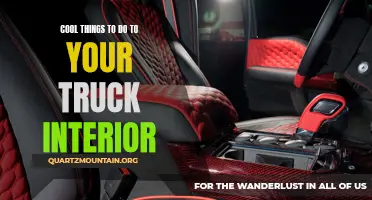
Are you planning a canoe trip soon? Whether you're a seasoned paddler or a beginner, it's essential to have the right gear and equipment for a successful adventure. In this guide, we'll explore the essential items you need to pack for a canoe trip. From life jackets and paddles to camping gear and navigation tools, we've got you covered. So grab your gear, hop in your canoe, and get ready for an unforgettable adventure on the water!
| Characteristics | Values |
|---|---|
| Canoe | One or more |
| Paddles | Two or more |
| Personal flotation devices (PFDs) | One per person |
| Safety whistle | One or more |
| Waterproof bags or dry bags | Multiple sizes |
| Sunscreen | One or more |
| Insect repellent | One or more |
| First aid kit | Basic supplies |
| Water bottles | Sufficient for hydration |
| Food | Non-perishable with sufficient calories |
| Cooking equipment | Stove, pot, utensils, fuel |
| Map and compass | Navigation tools |
| Extra clothing | Layers for different weather conditions |
| Hat | Protection from sun and rain |
| Sunglasses | UV protection |
| Rain gear | Jacket and pants |
| Tent | One or more |
| Sleeping bag | Appropriate for expected temperatures |
| Sleeping pad | Insulation from the ground |
| Headlamp or flashlight | Source of light |
| Fire-starting tools | Matches, lighter, fire starter |
| Knife or multitool | For various tasks |
| Rope or cord | Utility purposes |
| Spare paddle | Backup in case of breakage |
| Repair kit | For quick fixes |
| Trash bags | For waste disposal |
| Portable toilet system | For Leave No Trace principles |
What You'll Learn
- What essential items should I pack for a canoe trip?
- Are there any specific clothing items I should bring on a canoe trip?
- What kind of food should I pack for a canoe trip?
- Do I need any special gear or equipment for a canoe trip?
- Are there any safety items I should include in my packing list for a canoe trip?

What essential items should I pack for a canoe trip?

Canoeing trips are a great way to explore the outdoors and connect with nature. Whether you are planning a short day trip or a multi-day expedition, it is important to pack the right gear to ensure a safe and enjoyable adventure. Here are some essential items that you should pack for a canoe trip:
- Personal Flotation Devices (PFDs): Safety should always be your top priority when venturing out on the water. Make sure that each member of your group has a properly fitted PFD. It is essential to wear your PFD at all times while in the canoe, especially if you are not a strong swimmer.
- Waterproof Bags: Canoes and water often go hand in hand, so it is crucial to protect your gear from getting wet. Invest in a good quality dry bag or waterproof barrel to keep your clothes, food, and electronic devices dry. Pack your items in smaller waterproof bags within the larger bag to keep things organized and easily accessible.
- Navigation Tools: Depending on the complexity of your trip, you may need some navigation tools to help you find your way. A map and compass are essential for any backcountry journey. If you are planning to explore unfamiliar waters, consider bringing a GPS device or a waterproof and shockproof map navigation app on your phone.
- First Aid Kit: Accidents can happen even in the most remote locations, so it is important to be prepared. Pack a comprehensive first aid kit that includes bandages, antiseptic ointment, pain relievers, and any necessary prescription medications. Familiarize yourself with basic first aid procedures before your trip to ensure you can respond effectively in case of an emergency.
- Camping Gear: If you are planning an overnight trip, you will need to bring camping gear. This includes a tent, sleeping bag, sleeping pad, and cooking equipment. Opt for lightweight and compact gear to minimize the weight and size of your pack. Remember to also pack enough food and water to sustain yourself for the duration of your trip.
- Clothing: Dress for the weather and pack appropriate clothing for your canoe trip. Quick-drying and moisture-wicking materials are ideal as they will keep you comfortable even if you get wet. Bring enough layers to stay warm in cooler temperatures and pack a hat, sunglasses, and sunscreen to protect yourself from the sun.
- Repair Kit: It is always a good idea to be prepared for any equipment malfunctions that may occur during your trip. Pack a repair kit that includes duct tape, a multi-tool, spare parts, and a patching material for your canoe. These items can come in handy in case of unexpected repairs or emergencies.
- Personal Hygiene and Sanitation: Don't forget to pack personal hygiene items such as toilet paper, hand sanitizer, and biodegradable soap. Follow Leave No Trace principles and dispose of waste properly to minimize your impact on the environment.
Remember to check the local regulations and guidelines before your trip to ensure you are meeting all the requirements. By packing these essential items, you can have a safe and enjoyable canoe trip, knowing that you are well-prepared for whatever adventures come your way.
Essential Packing List for Your Buenos Aires Adventure
You may want to see also

Are there any specific clothing items I should bring on a canoe trip?

When preparing for a canoe trip, it is important to pack the right clothing items to ensure comfort and safety during your adventure. The right clothing can protect you from the elements and provide the necessary insulation in different weather conditions. Here are some specific clothing items you should consider bringing on a canoe trip:
- Quick-drying clothing: Since you'll be spending time on the water, it is essential to wear clothing that dries quickly. Opt for synthetic materials like nylon or polyester instead of cotton, as cotton takes a long time to dry and can leave you feeling cold and uncomfortable.
- Base layers: Base layers are designed to regulate body temperature by wicking away sweat from your skin. Look for moisture-wicking fabrics like merino wool or synthetic blends that will keep you dry and odor-free. These layers can be worn under your other clothing to provide insulation and keep you warm.
- Water-resistant outer layer: A water-resistant or waterproof jacket is essential to protect you from rain and splashes while canoeing. Look for jackets made from breathable materials that will keep you dry but not overly sweaty. It's a good idea to choose a jacket with a hood for added protection.
- Sun protection: Don't forget to pack sun-protective clothing, such as a hat with a wide brim and long-sleeved shirts. The sun's rays can be intense, especially when reflecting off the water's surface. Don't forget to apply sunscreen on exposed areas of skin as well.
- Footwear: Choose footwear that is comfortable and can withstand wet conditions. Water shoes or sandals with straps are a good option for canoeing. These shoes provide traction on slippery surfaces and will protect your feet from sharp objects in the water. Additionally, bring a pair of hiking boots or sturdy shoes for walking on land.
- Layering options: Weather conditions can change quickly, so it's essential to pack layering options. Consider bringing lightweight fleeces or sweaters that can be easily added or removed as needed. This way, you can adjust your clothing to stay comfortable in changing temperatures.
- Extra clothing: It's always a good idea to pack extra clothing items in case of emergencies or unexpected weather changes. Pack an extra set of base layers, socks, and underwear in case yours get wet. Having a dry set of clothing to change into can make a significant difference in your comfort level.
- Bug protection: Depending on your destination, insect bites can be a significant nuisance. Pack insect repellent clothing or spray to protect yourself from mosquitoes and other pests. Consider wearing long sleeves and pants to minimize exposure to bugs. Additionally, a bug net for your head or tent can provide extra protection.
Remember, while it's important to pack the right clothing, it's equally important to pack light and avoid overpacking. Choose versatile items that can be layered or worn in different ways to maximize your options while minimizing your luggage. By packing the right clothing items for your canoe trip, you can ensure a safe and comfortable adventure on the water.
Essential Items to Pack for a Memorable Family Ski Holiday
You may want to see also

What kind of food should I pack for a canoe trip?

When planning a canoe trip, it's important to choose the right food to pack. This not only ensures that you have enough energy to paddle and enjoy the trip, but also helps you stay nourished and satisfied throughout the journey. Here are some tips on what kind of food to pack for a canoe trip:
- Focus on lightweight and non-perishable options: Since you'll be carrying all your supplies in a canoe, it's important to pack food that is lightweight and won't spoil easily. Opt for dehydrated or freeze-dried meals, energy bars, nuts, dried fruits, and jerky. These foods are packed with nutrients and can be easily stored in waterproof bags or containers.
- Pack a variety of meals: While it might be tempting to stick to simple meals, such as sandwiches or canned goods, it's important to pack a variety of meals to keep your taste buds satisfied. Consider packing dehydrated soups, pasta, rice, and instant oatmeal for breakfast. Don't forget to pack some spices, salt, and pepper to enhance the flavor of your meals. If you have dietary restrictions or preferences, make sure to accommodate them by selecting suitable options.
- Prioritize high-energy snacks: Paddling for long hours can be physically demanding, so it's crucial to pack high-energy snacks that can provide a quick boost. Energy bars, trail mix, and granola bars are excellent options as they contain a good balance of carbohydrates, proteins, and fats. These snacks are easy to consume on the go and can provide a quick burst of energy to keep you going.
- Consider your cooking options: Depending on the length and nature of your canoe trip, you may have access to different cooking methods. If you have the ability to cook over a campfire or portable stove, consider packing meals that require boiling water or simmering, such as instant noodles, macaroni and cheese, or dehydrated meals. If cooking isn't an option, focus on foods that can be consumed as is, like energy bars or jerky.
- Don't forget your hydration needs: Staying hydrated is crucial during any outdoor adventure, so make sure to pack enough water. Opt for a sturdy water bottle or hydration bladder that you can easily refill along the way. Additionally, consider packing some powdered electrolyte mixes to replenish your electrolyte levels, especially if you'll be paddling for long hours under the sun.
Remember to pack enough food to last the duration of your canoe trip, considering the number of meals and snacks you'll need each day. It's always better to have some extra food just in case of unexpected delays or emergencies. By choosing lightweight, non-perishable, and high-energy options, you'll be well-prepared for your canoe trip and ensure that you have the necessary fuel to enjoy the great outdoors.
Choosing the Right Barrier for Dense Pack Cellulose Insulation: Factors to Consider
You may want to see also

Do I need any special gear or equipment for a canoe trip?

If you're planning a canoe trip, it's important to make sure you have the right gear and equipment to ensure a safe and enjoyable experience. While the specific gear you'll need can vary depending on the location and length of your trip, there are some essential items that every canoeist should have.
First and foremost, you'll need a canoe. Canoes come in a variety of sizes and materials, so choose one that suits your needs and experience level. If you're new to canoeing, a stable and easy-to-handle recreational canoe is a good choice. If you're planning on tackling whitewater or longer trips, you may want to invest in a more specialized canoe.
Next, you'll need paddles. Paddles should be the correct length for your height and the width of your canoe. They should also be lightweight and durable. Look for paddles with comfortable grips and sturdy blades. It's a good idea to have a spare paddle in case one gets lost or damaged during your trip.
A personal flotation device (PFD) is an essential piece of gear for any canoe trip. It's important to choose a PFD that fits properly and is comfortable to wear. Make sure it is approved by the relevant safety authorities and meets the required standards. A PFD can save your life in the event of an accident or capsize, so it's not something to skimp on.
In addition to a PFD, you'll also want to have a helmet if you're planning on canoeing in whitewater or other challenging conditions. A helmet can protect your head from rocks and other hazards in the water.
Depending on the weather and location of your trip, you may also need a wetsuit or drysuit. These will help keep you warm if you capsize or get wet. It's important to choose a suit that is appropriate for the water temperature and conditions you'll be paddling in.
Other essential gear includes a safety kit with a whistle, flashlight, and first aid supplies. You should also have a throw rope, which can be used to rescue someone who has fallen out of the canoe. A waterproof map and compass are also important for navigation, especially if you'll be paddling in unfamiliar waters.
Don't forget to bring plenty of water and food for your trip, as well as a water filtration system or purification tablets if you'll be drinking from natural sources. A dry bag or waterproof container will keep your belongings dry in case of rain or splashes.
Finally, dress appropriately for the weather and bring sun protection such as sunscreen, sunglasses, and a hat. It's also a good idea to wear quick-drying clothing and sturdy footwear.
In conclusion, while the specific gear and equipment you'll need for a canoe trip can vary depending on the location and length of your trip, there are some essential items that every canoeist should have. These include a canoe, paddles, a PFD, and a helmet if necessary. Other important gear includes a safety kit, a throw rope, a map and compass, and waterproof containers. Be sure to dress appropriately for the weather and bring plenty of water and food. By having the right gear and equipment, you'll be well-prepared for a safe and enjoyable canoe trip.
Essential Items to Pack for Your Ben Nevis Adventure
You may want to see also

Are there any safety items I should include in my packing list for a canoe trip?

Canoeing is a thrilling and enjoyable outdoor activity, but it's important to be prepared and prioritize safety. Whether you're an experienced paddler or embarking on your first canoe trip, having the right safety items in your packing list can make all the difference in the event of an emergency. Here are some essential safety items you should include:
- Personal Floatation Devices (PFDs): Every person on board should have a properly fitting PFD. PFDs are crucial for staying afloat in case of capsizing or falling overboard. Make sure to choose PFDs that are approved by relevant authorities and provide adequate buoyancy for your body weight.
- Safety Whistle: A safety whistle is a simple yet effective tool for attracting attention during an emergency. It can be heard over long distances and is a universal distress signal recognized by both rescuers and fellow paddlers. Attach a whistle to your PFD or keep it easily accessible.
- Waterproof Dry Bags: Protecting your gear from water is essential on a canoe trip. Invest in high-quality waterproof dry bags to keep your personal belongings and supplies dry. These bags should be large enough to hold your essentials such as spare clothing, food, and electronic devices.
- First Aid Kit: Accidents happen, even on the water. Pack a well-stocked first aid kit that includes basic supplies like bandages, antiseptic wipes, adhesive tape, pain relievers, and any personal medications. Familiarize yourself with the contents of the kit and ensure you know how to use them.
- Navigation Tools: While modern technology has made navigation easier, it's always wise to have a backup. Carry a waterproof map of the area, a compass, and a GPS device or smartphone with a navigation app. These tools will help you stay on course and avoid getting lost.
- Knife and Rope: A sturdy knife and a length of rope are invaluable tools in various emergency situations. A knife will come in handy for cutting rope, creating improvised shelter, or freeing yourself from entanglements. The rope can be used for towing, building a shelter, or securing gear.
- Emergency Communication Device: In areas with no cellphone signal or in case of a more serious emergency, it's important to have an emergency communication device such as a satellite phone or radio. These devices can be a lifeline to call for help in remote locations.
- Snacks and Water: Staying hydrated and nourished is essential for maintaining energy levels during a canoe trip. Pack plenty of water in reusable bottles and bring energy-rich snacks like granola bars, trail mix, or dried fruits.
- Extra Clothing and Rain Gear: Even on a sunny day, weather conditions can quickly change on the water. Pack extra clothing in case you get wet or it gets colder than expected. Include a waterproof jacket, pants, and a hat to protect against rain and wind.
- Personal Locator Beacon (PLB): For extended trips or when venturing into remote areas, carrying a Personal Locator Beacon can be a lifesaver. These devices can transmit distress signals via satellite, alerting emergency services to your location.
Remember, having these safety items is just the first step. It's essential to familiarize yourself with their usage and practice basic safety skills before embarking on your canoe trip. Listen to weather forecasts, follow safety guidelines, and never paddle alone. By prioritizing safety and being prepared, you can enjoy a fantastic canoe trip while mitigating potential risks.
Essential Winter Travel Items for Men Visiting Israel
You may want to see also
Frequently asked questions
For a canoe trip, it is important to bring essential items such as a tent, sleeping bag, cooking utensils, food, water, extra clothing, a first aid kit, a map and compass, a waterproof bag or dry bag to keep belongings safe and dry, and a life jacket or personal flotation device (PFD) for each person.
The amount of food and water you should bring depends on the length of your trip and the number of people in your group. As a general rule, plan to bring enough food for three meals per day plus snacks. For water, it is recommended to bring at least one gallon per person per day for drinking, cooking, and cleaning.
When packing clothing for a canoe trip, it is important to consider the weather conditions and the activities you will be engaging in. It is a good idea to bring multiple layers of clothing, including quick-drying and moisture-wicking materials, as well as a waterproof jacket or rain gear. Don't forget to pack a hat, sunglasses, and sunscreen to protect yourself from the sun.
Yes, it is essential to bring camping gear for a canoe trip. This includes a tent, sleeping bag, sleeping pad, and camping stove, as well as any other personal items you may need, such as a toiletry kit and a headlamp or flashlight. It is also important to bring a camping chair or campsite seating for added comfort while at the campsite.
In addition to the essential items mentioned earlier, there are a few additional items you may want to consider packing for a canoe trip. These include bug spray or insect repellent, a multi-tool or Swiss Army knife, a fishing rod and tackle if you plan on fishing, a camera or binoculars to capture memories or enjoy wildlife viewing, and a portable camping shower or towel for personal hygiene.







